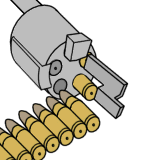Well, apparently
no one can explain how the Korobov works; the one you see was put together from parts in his prototyping shop decades after his death by a museum/university

. Lots of threads out there trying to decipher it (like the Antikythera Mechanism, or something) with no conclusive answer; maybe there never was one. My theory is they put the mag in the wrong hole (almost all of Korobov's other designs have the mag
connected to the end of the pistol grip) and made up the rest

The main principle behind the falling block autos (of which the Madsen is the only one) is to have the bolt carrier/piston drop the block clear of the lugs the same way it would tilt or rotate it in a reciprocating actions. The difference from then on is that the reciprocating bolt carrier is what extracts and loads the rounds, as opposed to the bolt body; different, but really not
that crazy in concept.
In the Madsen, which is a recoil operated design, the barrel/breech-block unit is functionally the receiver (holds the breech together when locked) and the externally-fixed housing the whole mess rides in operates like a bolt carrier. For my MP57 design based somewhat on the Madsen, the barrel/breech-block unit are fixed, and a piston drives rails alongside the action which drop/lift the bolt, and extract/feed the 5.7x28 rounds. Instead of dropping rounds into a slot on the side of the bolt, thus guaranteeing an awkward, non-ambidextrous design, I spin the round 90degrees into two opposing 'hooks' which constrain its motion is it is fed into the chamber on the return stroke --thus the PS90 mag.
"but you know, i notice a huge advantage to the madsen system"
Huge advantages to the Madsen system. It was just so awkwardly executed that no one saw them before crap like the BREN took over*. Basically, the Madsen dispels with most (all?) cartridge cycling issues so long as a minimum level of energy is dumped in the system by the cartridge (same as all autos). And it does this in a far more compact package than even the AR Stoner bolt can pull off, since that action still has to double in length to operate when the bolt retracts. The Madsen merely doubles in height when the bolt drops

TCB
*Not knocking the BREN; by contrast it was an exceedingly elegant execution of a brutally simplistic and unrefined action concept
"as for your skorpion design, id be willing to discuss that too..."
Ergonomical Inquisitations Requesterated --admittedly not the most descriptive title, but I
was only asking for advice on where to place a grip safety











